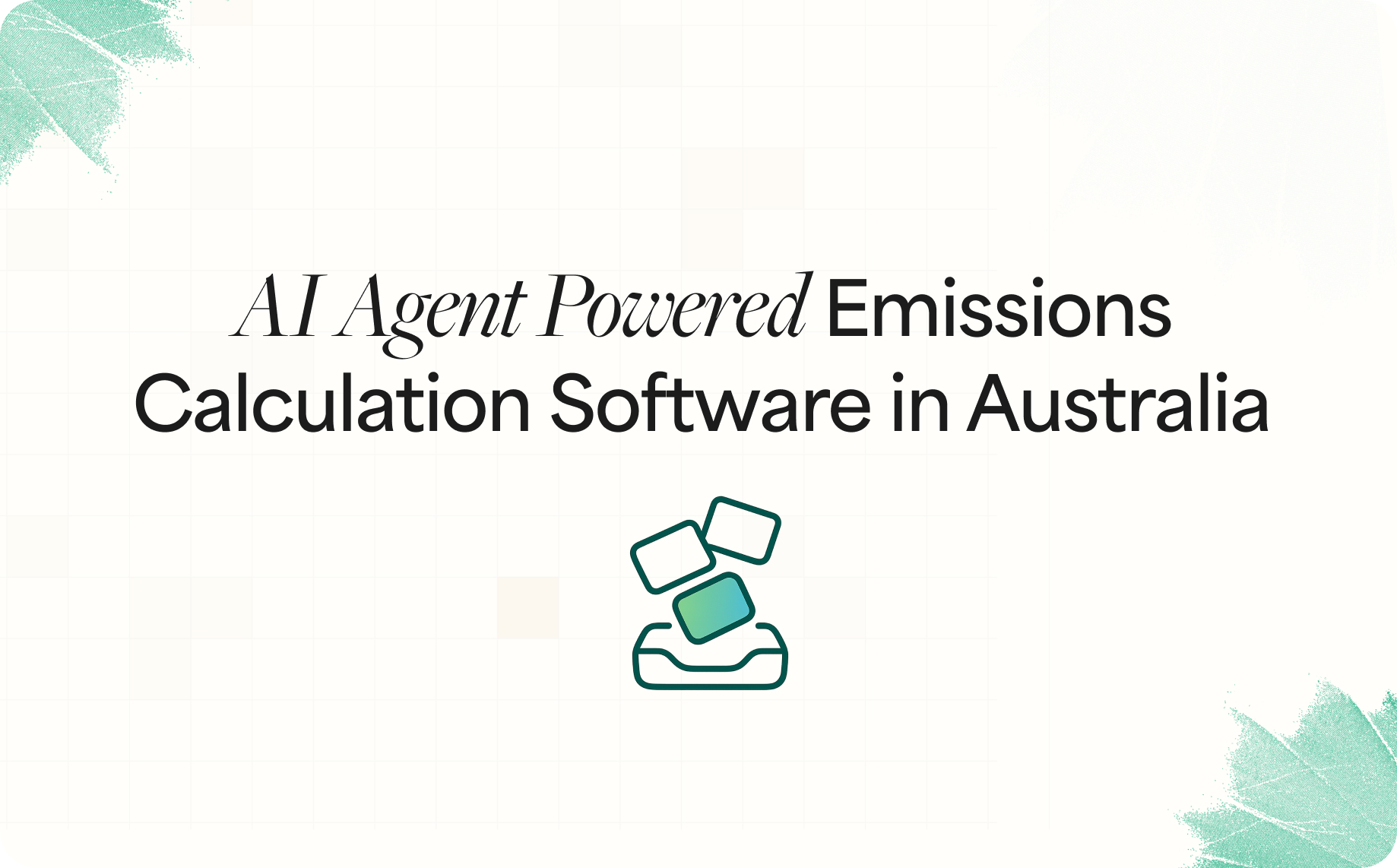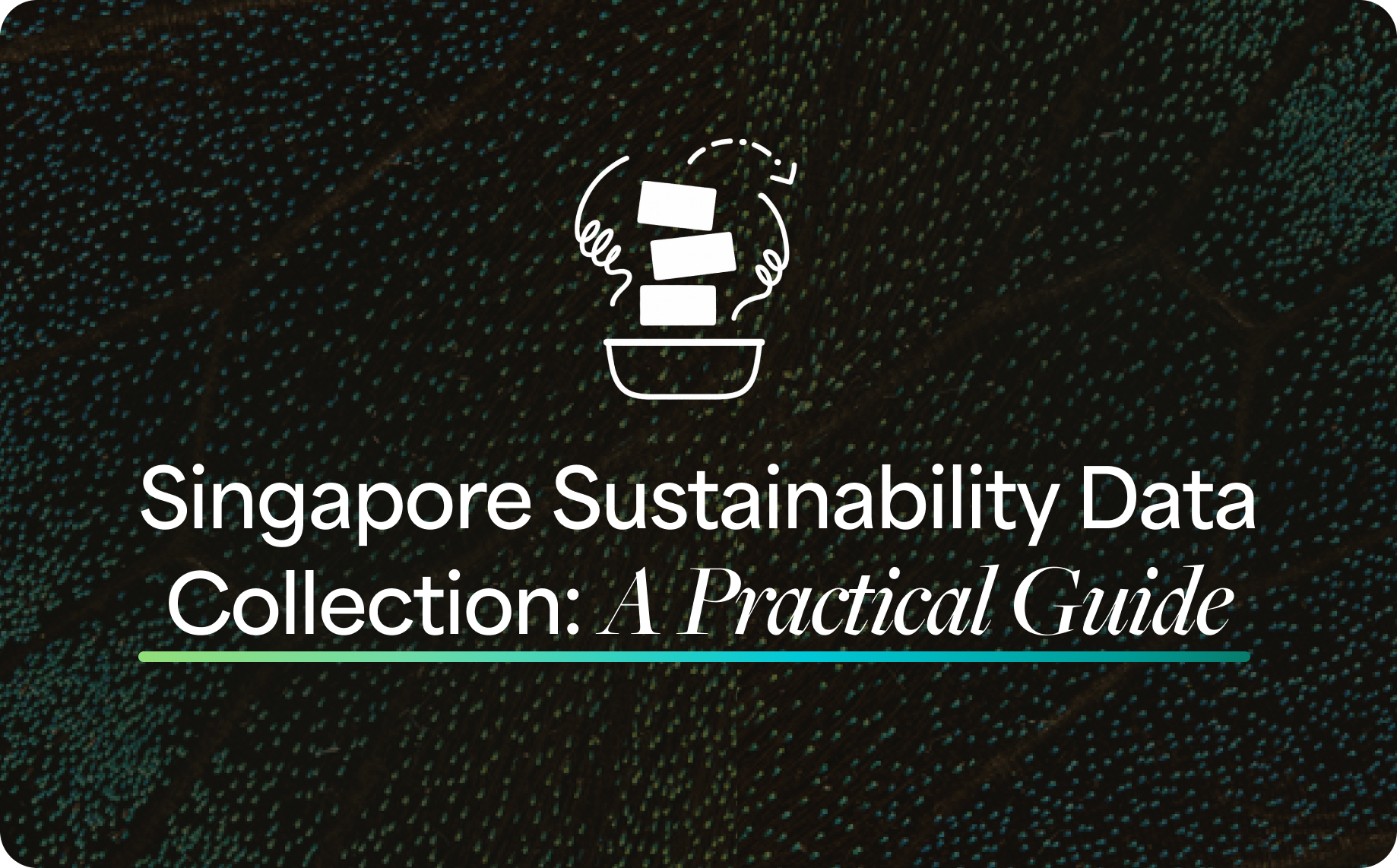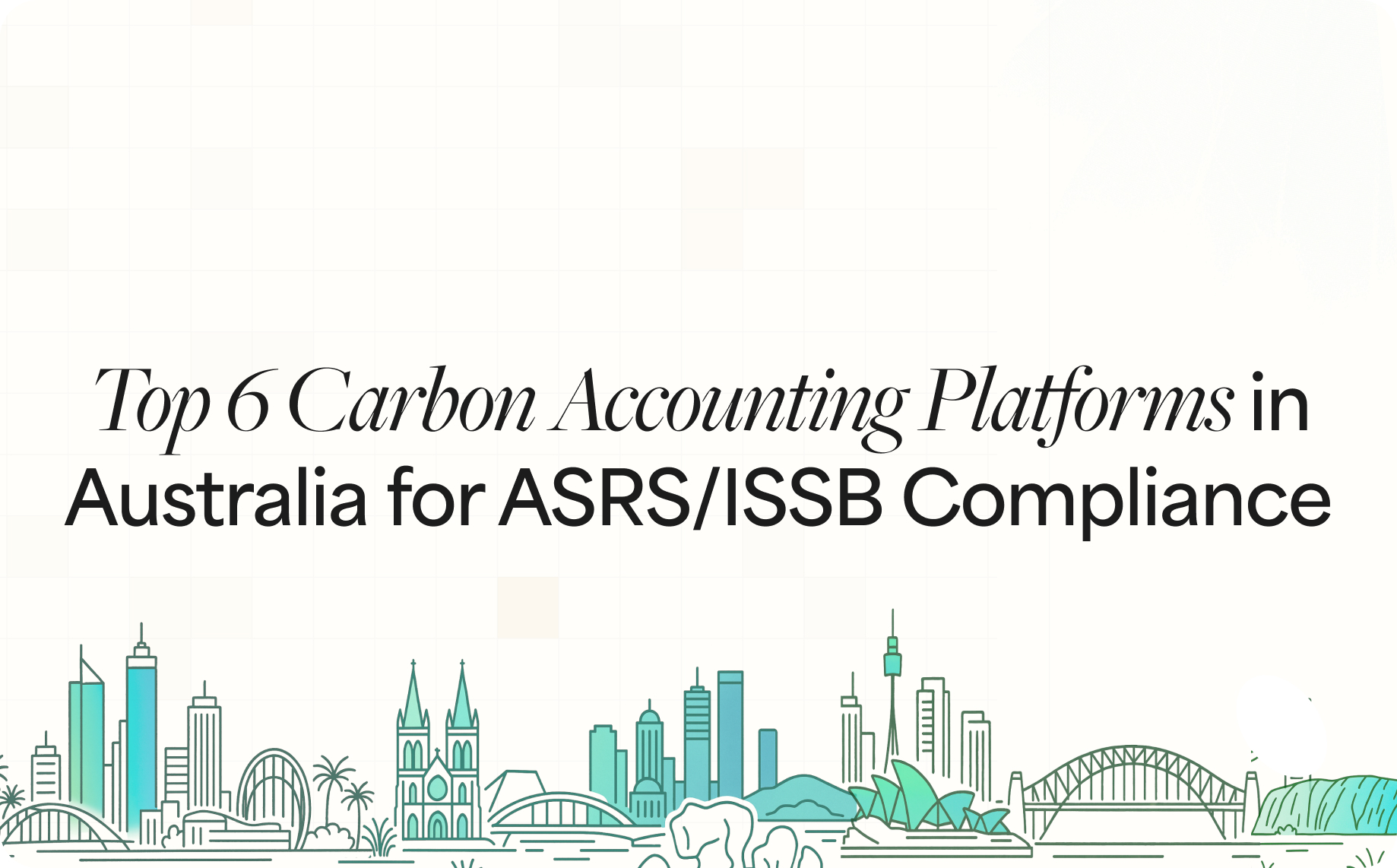What is a Product Carbon Footprint (PCF)?
A Product Carbon Footprint (PCF) quantifies the total greenhouse gas emissions generated by a product throughout its entire lifecycle. This includes emissions from raw material extraction, manufacturing, transportation, use, and end-of-life disposal, all measured in carbon dioxide equivalents (CO₂e). Unlike a corporate carbon footprint, which covers an organization's overall emissions, a PCF provides a granular, product-specific view—necessary for credible climate action, regulatory compliance, and supply chain transparency.
Why Does Product Carbon Footprint Software Matter?
Market Expectations
72% of global consumers are willing to pay more for sustainable products, and 85% of consumers report experiencing climate change impacts firsthand. Product carbon footprint software enables companies to provide transparent emissions data that meets growing consumer demand for sustainability credentials.
Investor Demands
Institutional investors increasingly require product-level emissions data for ESG risk assessment. Product carbon footprint software provides the granularity and defensibility investors need to evaluate supply chain risks and decarbonization progress.
Decarbonization Strategy
PCF analysis identifies emission hotspots across the product lifecycle, enabling targeted reductions and more sustainable product design. Product carbon footprint software transforms emissions measurement from a compliance exercise into a strategic decarbonization tool.
How to Measure a Product Carbon Footprint with PCF Software
1. Define Scope and Objectives
Determine the purpose: benchmarking, compliance, or decarbonization. Define system boundaries: cradle-to-gate (up to factory gate) or cradle-to-grave (full lifecycle). Product carbon footprint software guides this scoping process, ensuring alignment with ISO 14067 and GHG Protocol requirements.
2. Map the Product Lifecycle
Identify all stages: raw materials, manufacturing, packaging, transport, use, and disposal. Product carbon footprint software automates lifecycle stage mapping, reducing manual effort and improving consistency.
3. Collect Data
Primary Data: Direct from suppliers or operations (energy consumption, materials).
Secondary Data: Industry databases when primary data is unavailable.
Product carbon footprint software streamlines data collection through automated supplier engagement, integrations with ERP systems, and AI-assisted data validation.
4. Calculate Emissions
Multiply activity data by emission factors for each lifecycle stage. Product carbon footprint software applies appropriate emission factors automatically, ensuring calculation accuracy and GHG Protocol alignment.
5. Review and Report
Document assumptions, assess data quality, and report emissions per functional unit. Product carbon footprint software provides audit trails, evidence storage, and regulatory-aligned reporting templates.
Key Methodologies and Standards for Product Carbon Footprint Software
- ISO 14067: Specifies requirements for quantifying and reporting PCF.
- GHG Protocol: The global benchmark for GHG accounting.
Leading product carbon footprint software solutions integrate these frameworks, automating compliance and reducing regulatory complexity. The Unravel Carbon PCF Module complies with the ISO 14067 standard.
PCF Software Implementation Challenges and How a Platform and AI Agents Address Them
Measuring product carbon footprint faces significant implementation barriers that prevent organizations from scaling their sustainability efforts. Modern PCF platforms equipped with AI capabilities directly address these challenges through automation, standardization, and intelligent data processing.
Data Collection Complexity Across Supply Chains
The most significant challenge in PCF implementation is gathering accurate and comprehensive data across complex, multi-tier supply chains. Organizations often lack sufficiently granular primary data from actual measurements.
Platform Solution: Unravel Carbon's PCF module addresses this through structured bulk upload capabilities that accept both CSV and Excel formats. The platform provides standardized template downloads that guide users in organizing product data with required fields including lifecycle stages, resource types, quantities, and data quality designations. This systematic approach reduces manual effort while maintaining data integrity through built-in validation checks.
Emission Factor Matching and Database Accuracy
Identifying appropriate emission factors for diverse activities presents substantial difficulty, particularly for unique or specialized processes.
Data inaccuracy in emission factors can lead to errors in emission estimation. The lack of accessible, up-to-date emission factors creates bottlenecks in carbon accounting.
Unravel Carbon's PCF calculation engine provides advanced search filters that enable users to locate appropriate emission factors by selecting parameters such as location and input type. The platform maintains transparent sourcing information from reputable databases including industry sources, research organizations, and government agencies. The engine automatically retrieves emission factors based on resource type, converts input quantities to align with factor units, and calculates final emissions following ISO 14067 methodology.
Lifecycle Stage Complexity and Boundary Definition
Conducting comprehensive lifecycle assessments requires detailed analysis across cradle-to-gate or cradle-to-grave boundaries, involving raw material extraction, manufacturing processes, transportation, and waste management. This complexity often proves resource-intensive and prone to error.
The Template Management system allows users to create reusable structures for different product types, ensuring consistency across multiple assessments. Users can select relevant lifecycle stages, delete non-applicable stages, and add hierarchical sections and subsections within each stage. Mandatory sections can be designated to ensure critical data points are captured in every assessment. This structured approach significantly improves efficiency by pre-defining required lifecycle stages and data points for specific product categories.
Manual Entry Errors and Data Processing Scale
Organizations often receive hundreds of PCF requests from customers. Without automation, calculating emissions involves managing large data volumes across multiple lifecycle stages, becoming resource-intensive and prone to human error, especially for extensive product portfolios.
Unravel Carbon supports both manual entry for targeted small-scale input and streamlined bulk upload for large datasets. The bulk upload feature allows users to populate downloaded spreadsheet templates and import complete datasets through a review process before finalization. Once imported, data becomes immediately accessible on corresponding product pages. The platform performs automated data validation checks, displaying clear error messages for incorrect formats, missing fields, or invalid units to guide corrections.
Inconsistent Methodologies and Standardization
Organizations encounter differences in approaches across frameworks such as GHG Protocol, ISO 14067, PAS 2050, and PACT, making it challenging to ensure comparability and compliance. ISO 14067 requires detailed lifecycle assessment involving product system boundaries, primary data collection, and methodology transparency.
Unravel Carbon's PCF calculation methodology aligns with ISO 14067 standard and the GHG Protocol, with the platform certified to ISO 14067 to validate accuracy and reliability.
Scenario Analysis and Reduction Planning
Organizations need capabilities to explore different scenarios and assess potential impacts of material changes or energy source alternatives. Traditional approaches lack dynamic modeling for evaluating decarbonization strategies.
Unravel Carbon's PCF agent includes scenario analysis functionality that allows users to model the effect of changes such as using alternative materials or different energy sources. The Results Analysis tools provide emission hotspot identification through lifecycle stage breakdowns, enabling organizations to identify which stages contribute most significantly to total carbon footprint.
Reporting and Transparency Requirements
Organizations require transparent carbon footprint information to stakeholders, with
clear documentation of methodologies, data sources, and calculation procedures. Manual reporting processes struggle to meet regulatory and market demands.
Once all required fields in the Details section are completed—including Time Boundary, Time Boundary Reasons, and System Boundary Intended Communication—assessments can be published. The platform generates standardized two-page reports summarizing the product's carbon footprint. These exports provide formal documentation that meets reporting standards while maintaining calculation transparency through audit trail features.
Scalability for Large Product Portfolios
Companies with large product portfolios and limited resources face challenges supporting calculations, particularly when primary data collection issues create additional gaps.
The template-based approach enables scalability by allowing published templates to be reused across multiple product assessments. The platform's Product Builder Dashboard displays resulting emission data after activity and resource data entry and calculation, providing at-a-glance views of product footprints. This systematic structure allows organizations to maintain consistency while scaling PCF calculations across extensive product ranges.
Modern PCF platforms combining structured methodologies with AI-powered automation transform implementation from a resource-intensive manual process into a scalable, accurate, and standardized operation. By addressing data collection complexity, emission factor matching, lifecycle management, validation, and reporting through intelligent platform design, organizations can overcome traditional barriers and achieve comprehensive product carbon footprinting at enterprise enterprise scale.
How Unravel Carbon's AI Agents Will Enhance Product Carbon Footprint Software
Unravel Carbon's AI agents will introduce specialized, autonomous functionality to automate and strengthen every aspect of PCF measurement and management.
Product Carbon Footprint Agent
Automated BoM Ingestion
The PCF Agent will ingest and transform raw bills of materials to build detailed product carbon footprints, supporting cradle-to-gate or cradle-to-grave analysis within the product carbon footprint software platform.
Agentic Chat Interface
Users will interact with an AI agent that guides them through the PCF workflow, asks clarifying questions, suggests data sources, and flags missing information in real time.
Scenario Analysis
Instantly model the impact of supplier location, specific supplier selection, material choice, and transportation modes on your product's carbon footprint within the product carbon footprint software—before making costly changes.
Regulatory-Ready Outputs
All calculations will be aligned with ISO 14067 with pre-configured reporting templates.
The result: Unravel Carbon's PCF Module and PCF Agent will shift PCF measurement from a manual, retroactive process to an automated, proactive, and design-integrated workflow.
With the launch of the PCF Agent and supporting AI modules, Unravel Carbon will offer a fully agentic, scenario-driven, and automated product carbon footprint software solution—enabling your organization to design, procure, and report with confidence and precision.
Want to see how Unravel Carbon's product carbon footprint software can help your organization achieve accurate, auditable, and actionable product carbon footprints?
Drop us a line or get in touch with our team via hello@unravelcarbon.com
Key Terms Explained
Product Carbon Footprint (PCF): Total GHG emissions from a product's lifecycle, measured in CO₂e.
Product Carbon Footprint Software: Platforms that automate PCF measurement, calculation, reporting, and scenario analysis.
Cradle-to-Gate / Cradle-to-Grave: System boundaries for PCF—up to factory gate or full lifecycle.
Bills of Materials (BoM): Detailed list of all components and materials in a product.
Emission Factors: Standardised values for GHG emissions per unit of activity or material.
Scenario Analysis: Modeling the impact of changes (materials, suppliers, processes) on PCF within product carbon footprint software.
Agentic Capabilities: AI-driven, interactive features that guide users through complex workflows in product carbon footprint software.
Frequently Asked Questions
How does Unravel Carbon's PCF Module ensure PCF data accuracy and auditability?
Unravel Carbon's product carbon footprint software uses AI-driven data validation, anomaly detection, and audit trails for every calculation. All outputs are aligned with GHG Protocol and ISO 14067, ensuring regulatory-grade accuracy.
What makes Unravel Carbon's PCF Module different from other platforms?
Unravel combines agentic AI guidance, scenario analysis, and regulatory-ready reporting in one product carbon footprint software platform—delivering faster, more accurate, and more actionable PCF insights. The platform's 136,000 proprietary emission factors provide depth unavailable elsewhere.
Sources
- ISO 14067:2018 - Product Carbon Footprint Standard
- PwC Consumer Survey 2024 - Sustainability Premium
- Arbor: Sustainability Statistics 2025
- Unravel Carbon Feature Compendium - verified against official knowledge base
- Verdantix: Three Main Challenges For Product Carbon Footprint – And How Software Can Help





